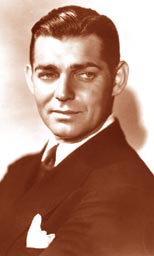|
Sunday, June 21, 1998
`Gone With The Wind': Back To Big-Screen Glory
By John Hartl
Seattle Times Movie Reviewer
Honored last week in an American Film Institute television special as one of
the great American movies, David O. Selznick's "Gone With the Wind" will be
celebrating its 60th anniversary soon.
Its new theatrical distributor, New Line Cinema, is treating it with the
respect due a movie that has sold more tickets than any other single event in
entertainment history.
The company has spent more than $1 million to restore the Civil War epic to
something like its original big-screen, three-strip Technicolor glory. It opens
in more than 200 theaters on Friday.
New Line is promising "an extensive and elaborate" restoration that is "not
subtle, but clearly audible to the ear and visible to the naked eye . . . the
focus is clearer, almost three-dimensional, and the resolution is sharper. With
the three-strip process, audiences can gauge variances in everything from the
warm hues of a skyline to skin tones to the texture of fabric in a costume."
The original camera negatives have suffered damage over the years, so EDS
Digital Studios has removed the imperfections by copying the film into its
computers and electronically removing the scratches before restoring it to 35mm
film.
The soundtrack was reworked by Chace Sound, which was founded by Rick Chace, a
former technician at KVOS-TV in Bellingham, whose "Chace Surround" system
creates stereo effects for video releases of mono movies.
"Gone With the Wind" went through its first major
reconstruction in 1967. At the time, a composite negative was made for a
70-millimeter reissue that grossed $30 million during the Vietnam War years.
It's been almost a decade since the last major restoration of "Gone With the
Wind," which set box-office records in 1989 at Radio City Music Hall in New
York and the Castro Theater in San Francisco.
Right from the beginning, "Gone With the Wind" has been a blockbuster. Margaret
Mitchell's book had already been a massive best-seller when the movie, starring
the then-unknown Vivien Leigh as Scarlett O'Hara and Clark Gable (the people's
choice to play Rhett Butler), arrived in theaters during the early days of
World War II.
"A capacity audience at 10 o'clock in the morning paid the picture the homage
of breathless attention for almost four mortal hours without a letup," reported
J. Willis Sayre when the film was reviewed in The Seattle Times on Jan. 26,
1940.
"And the only complaint heard from the vast throng was that the picture isn't
long enough. It cast such a spell that nobody wanted to go home."
For the past six months, "Titanic" has challenged "Gone With the Wind's" status
as the No. 1 box-office attraction. In terms of dollars, "Titanic," which will
be released to video Sept. 1, has grossed more. In terms of tickets sold, it
lands in the No. 8 position on the top 10.
According to Variety, "Gone With the Wind" has sold more than twice as many
tickets as "Titanic."
Of course, it had a 58-year head start, but the average ticket price in the
1930s was 25 cents. In the late 1990s, it's about $5. Here's Variety's all-time
top 10 for the U.S. and Canada, adjusted for inflation:
1. "Gone With the Wind," $1.3 billion.
2. "Snow White and the Seven Dwarfs," $1 billion.
3. "Star Wars," $812 million.
4. "E.T. - The Extraterrestrial," $725 million.
5. "101 Dalmatians" (1961 version), $657 million.
6. "Bambi," $646 million.
7. "Jaws," $590 million.
8. "Titanic," $585 million.
9. "The Sound of Music," $565 million.
10. "The Ten Commandments" (1956 version), $548 million.
|
